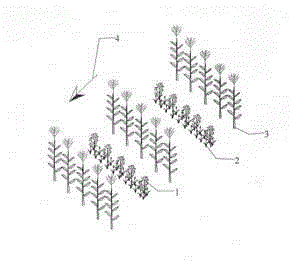Wind and sand prevention method of young fruit trees by interplanting crops
A technology for preventing wind and sand and fruit trees, applied in botany equipment and methods, climate change adaptation, horticulture, etc., can solve the problems of fruit farmers having no economic income and reducing surface wind speed, so as to solve the problems of no economic income, prevent wind erosion of farmland, and reduce wind speed Effect
- Summary
- Abstract
- Description
- Claims
- Application Information
AI Technical Summary
Problems solved by technology
Method used
Image
Examples
Embodiment 1
[0019] a, fruit trees 1 are planted in rows, and the direction of the planting rows is nearly perpendicular to the 4 angles included in the local prevailing wind direction;
[0020] b. Plant an annual low-stalk crop 2 wheat at a distance of 10 cm before and after the foundation of one row of fruit trees to prevent wind erosion of the roots of fruit trees;
[0021] c, planting the tall straw crop 3 cotton with relatively dense branches and leaves and thick stems in the middle of the row between the two rows of fruit trees 1;
[0022] d. As the fruit trees grow up, stop planting the low-stalk plant 2 wheat at the base of the 1-year fruit tree, and stop the planting of the high-stalk plant 3 cotton between the 3-year fruit tree and 1 row.
Embodiment 2
[0024] a, fruit trees 1 are planted in rows, and the direction of the planting rows is nearly perpendicular to the 4 angles included in the local prevailing wind direction;
[0025] b. Plant an annual low-stalk crop 2 soybeans at 20cm before and after the foundation of one row of fruit trees to prevent wind erosion of the roots of fruit trees;
[0026] c, planting the tall straw crop 3 corn with denser branches and leaves and thick stems in the middle of the row between the two rows of fruit trees 1;
[0027] d. As the fruit trees grow up, the planting of the low-stalk plant 2 soybean at the base of the 2-year fruit tree 1 is stopped, and the planting of the high-stalk plant 3 corn at the beginning of the 4-year fruit tree 1 row is stopped.
Embodiment 3
[0029] a, fruit trees 1 are planted in rows, and the direction of the planting rows is nearly perpendicular to the 4 angles included in the local prevailing wind direction;
[0030] b. Plant an annual low-stalk crop 2 peas at 25cm before and after the foundation of one row of fruit trees to prevent wind erosion of the foundations of fruit trees;
[0031] c, in the middle of the row between the two rows of fruit trees 1, plant the taller straw crop 3 sorghum with denser branches and leaves and thicker stems;
[0032] d. As the fruit trees grow up, the planting of the low-stalk plant 2 peas at the base of the 3-year fruiting tree 1 is stopped, and the planting of the high-stalk plant 3 sorghum at the 1 row of the 5-year fruiting tree is stopped.
PUM
 Login to View More
Login to View More Abstract
Description
Claims
Application Information
 Login to View More
Login to View More - R&D
- Intellectual Property
- Life Sciences
- Materials
- Tech Scout
- Unparalleled Data Quality
- Higher Quality Content
- 60% Fewer Hallucinations
Browse by: Latest US Patents, China's latest patents, Technical Efficacy Thesaurus, Application Domain, Technology Topic, Popular Technical Reports.
© 2025 PatSnap. All rights reserved.Legal|Privacy policy|Modern Slavery Act Transparency Statement|Sitemap|About US| Contact US: help@patsnap.com

